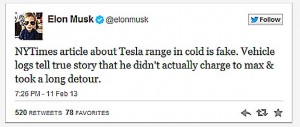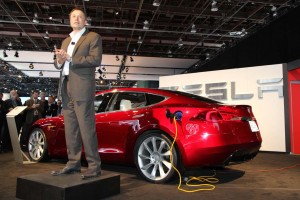Never shy to take on a major media outlet that has leveled criticism at his products, Tesla Motors CEO Elon Musk is accusing the New York Times of publishing a “fake” story regarding a lengthy drive of the battery-car start-up’s Model S sedan.
The entrepreneur – who also founded the Space X rocket company – took offense to a report by Times correspondent John Broder who claims he was unable to complete a drive from Washington, D.C. to Boston and had to finish the trip on a flatbed.
Musk has shown a prickly sensitivity to negative reviews and also filed suit against the popular BBC automotive series, “Top Gear,” when it ran a story claiming Tesla’s earlier Roadster model ran out of juice during testing.
“NYTimes article about Tesla range in cold is fake. Vehicle logs tell true story that he didn’t actually charge to max & took a long detour,” Musk declared in one of several Tweets he has issued about the Times review.
 He also noted that, “Tesla data logging is only turned on with explicit written permission from customers, but after Top Gear BS, we always keep it on for media.”
He also noted that, “Tesla data logging is only turned on with explicit written permission from customers, but after Top Gear BS, we always keep it on for media.”
The Times has meanwhile fired back, issuing a statement that, “Any suggestion that the account was ‘fake’ is, of course, flatly untrue.”
It added that, “Our reporter followed the instructions he was given in multiple conversations with Tesla personnel. He described the entire drive in the story; there was no unreported detour. And he was never told to plug the car in overnight in cold weather, despite repeated contact with Tesla.”
The controversy centers around the new Tesla Model S which went on sale last July. The battery-car maker has introduced three primary versions of the sedan with company-defined ranges of 160, 230 and 300 miles – though the EPA ratings are lower. Until recently, Tesla was producing only the longest-range model.
The test drive was designed to experience not just the Tesla Model S but also the network of so-called Supercharger stations that Tesla is setting up in primary markets. Using 480-volt current, they’re supposed to be able to deliver an approximately 80% charge in about a half hour, a fraction of the time it would normally require using a conventional, so-called Level II 240-volt charging system.
Broder reportedly plugged into Superchargers in Newark, Delaware and Milford, Connecticut. Even so, the veteran NY Times correspondent claims he couldn’t make it to the second charger before running out of power and required a flatbed to get there.
In his series of Tweets, Musk has suggested he will offer other journalists the opportunity to drive the Model S along the same route as the Times. That is leading to a flurry of hand-raising by automotive journalists who have been generally unable to get into the widely discussed battery car even seven months after its introduction.
In fact, spokeswoman Shanna Hendricks again advised TheDetroitBureau.com that, “We are limited by press car availability. We do not have huge fleets like other car makers.”
The lack of availability has made it extremely difficult to confirm Tesla’s claims for range with the Model S – which it contends is significantly greater than for any other battery vehicle now on the road. Other products, such as the Nissan Leaf and Ford Focus EV, deliver less than 100 miles per charge – albeit with significantly smaller battery packs.
It remains to be seen what Tesla might do beyond criticizing the Times’ story. It filed suit against the BBC, the producer of Top Gear, only to have the courts toss the maker’s claim out. The same thing happened after Tesla amended its legal claim, the court declaring, that what Top Gear aired was not “defamatory at all, or, if it is, it is not capable of being a sufficiently serious defamatory meaning to constitute a real and substantial tort.”


Tesla has it’s fair share of problems but not all in the media are scrupulous either. You will often see slanted stories for financial gains one way or the other. Those who wine and dine always come out ahead in the media.
Hi, Jorge,
I could point out “colleagues” whose work I wouldn’t bother to read, never mind trust. But I think the overwhelmingly majority of automotive journalists try to do the best job possible. Do some have biases that may influence their perspective, of course. And anyone who believes that there is such a thing as completely objective journalism is a fool. The simple act of choosing which quote or fact to use from a full notebook implies some subjective judgement. On the flip side, we see so many mainstream media going way out of the way to balance quote for quote. The last election cycle was a great example, stories finding ways to try to balance the opinion on a Senate candidate who contended women’s bodies have a way to “shut that thing down” after a rape to avoid pregnancy.
Okay, long rant. Here’s the thing, the NYT’s John Broder is about as good as it gets. I would suggest the odds of him trying to use that story to express his personal views on battery cars or Tesla are probably 100:1 against. Make that 1000:1. Might there eventually be some debate over his understanding of what was needed to maximize mileage? Perhaps. More likely, Elon is ranting against results he doesn’t like/
And, again, I will stress that Tesla PR is its own worst enemy. I have privately advised their team that they are winning few friends and cultivating ZERO credibility with their traditionally unhelpful behavior. I have anticipated that should something go wrong they’d not win much support. No surprise.
Paul A. Eisenstein
Publisher, TheDetroitBureau.com